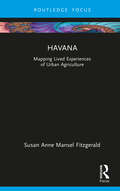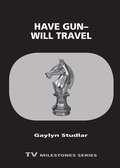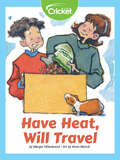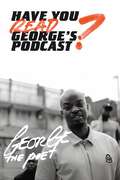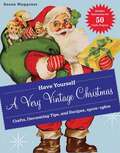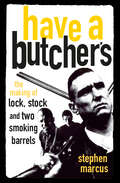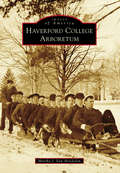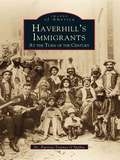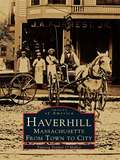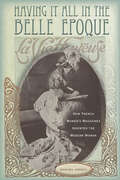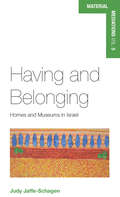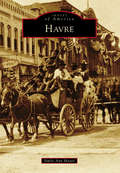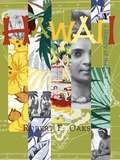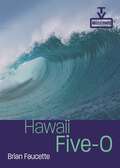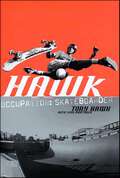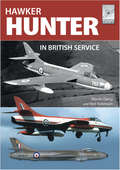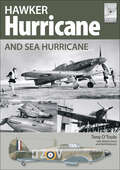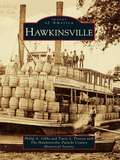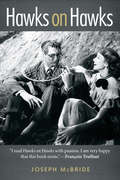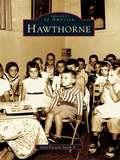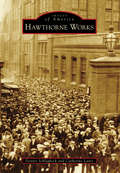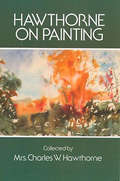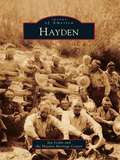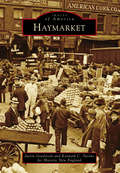- Table View
- List View
Havana: Mapping Lived Experiences of Urban Agriculture (Built Environment City Studies)
by Susan Anne FitzgeraldFollowing the crisis of the Special Period, Cuba promoted urban agriculture throughout its towns and cities to address food sovereignty and security. Through the adoption of state recommended design strategies, these gardens have become places of social and economic exchange throughout Cuba. This book maps the lived experiences surrounding three urban farms in Havana to construct a deeper understanding about the everyday life of this city. Using narratives and drawings, this research uncovers these sites as places where education, intimacy, entrepreneurism, wellbeing, and culture are interwoven alongside food production. Henri Lefebvre’s latent work on rhythmanalysis is used as a research method to capture the everyday beats particular to Havana surrounding these sites. This book maps the many ways in which these spaces shift power away from the state to become places that are co-created by the community to serve as a crucial hinge point between the ongoing collapse of the city and its future wellbeing.
Have Gun—Will Travel (TV Milestones Series)
by Gaylyn StudlarOne of the most successful series of its time, Have Gun--Will Travel became a cultural phenomenon in the late 1950s and made its star, Richard Boone, a nationwide celebrity. The series offered viewers an unusual hero in the mysterious, Shakespeare-spouting gunfighter known only as "Paladin" and garnered a loyal fan base, including a large female following. In Have Gun--Will Travel, film scholar Gaylyn Studlar draws on a remarkably wide range of episodes from the series' six seasons to show its sophisticated experimentation with many established conventions of the Western. Studlar begins by exploring how the series made the television Western sexy, speaking to mid-twentieth century anxieties and aspirations in the sexual realm through its "dandy" protagonist and more liberal expectations of female sexuality. She also explores the show's interest in a variety of historical issues and contemporaneous concerns--including differing notions of justice and the meaning of racial and cultural difference in an era marked by the civil rights movement. Through a production history of Have Gun--Will Travel, Studlar provides insight into the television industry of the late 1950s and early 1960s, showing how, in this transition period in which programming was moving from sponsor to network control, the series' star exercised controversial influence on his show's aesthetics. Because Have Gun--Will Travel was both so popular and so different from its predecessors and rivals, it presents a unique opportunity to examine what pleasures and challenges television Westerns could offer their audiences. Fans of the show as well as scholars of TV history and the Western genre will enjoy this insightful volume.
Have Heat, Will Travel
by Margie HillenbrandSmall animals like guinea pigs need a warm environment to live. Learn to make a fun and easy project using a cardboard box, old newspapers, and shavings that will help keep your small pet warm and safe! Now your small friend will be safe wherever it travels.
Have You Read George’s Podcast?
by George the Poet'There's something special about it: the storytelling is unique, so exciting, so kinetic. Even though it's in your ears, you feel like you're walking along with George.' -- Candice Carty-Williams'Have You Read George's Podcast? is a collection of the scripts of 28 of his podcasts. Even on the page, they are evidently brilliant, creating a shifting, shimmering world that remains anchored in the big questions of history, empire and identity that form the tec tonic plates of George's imagination.' -- Sunday Times '[George's podcast] blows through the medium's newly established boundaries, offering an experience as innovative as it is undefinable.' -- New Yorker'A genre-defying piece of audio that pushes the limits of what a podcast can be.' -- New York Times'There can't be many people out there who don't think George the Poet is a bit of a genius.' -- Charlie Phillips, Guardian***For fans of the critically-acclaimed, award-winning podcast Have You Heard George's Podcast?, a stunning collection of the scripts of the podcast, plus bonus material from George the Poet.There's nothing quite like Have You Heard George's Podcast?. Listeners and critics have struggled to fit it into just one neat category, jumping as it does between autobiography, fiction and social commentary, often in a single episode - and virtually all of it performed in spellbinding rhyming verse. And now the complete scripts of Chapters One, Two and Three are available to enjoy, along with new writing by George. This collection allows fans to read (and re-read) his words, and with new extra insights and commentary on each episode and Chapter. In the book, just as in the podcast, George The Poet delivers an incredibly powerful and unique perspective on politics, modern society, history and current affairs through the art of storytelling, speculative fiction and spoken word. The book also offers a deeply personal summation of George's observations, experiences and vision for the future. Whilst his narrative takes us all around the world, the ultimate ambition is to empower the next generation, starting with his community.
Have Yourself a Very Vintage Christmas: Crafts, Decorating Tips, and Recipes, 1920s–1960s
by Susan WaggonerRecapture the magic of Christmases past with fifty easy-to-make craft projects, candy recipes, and nostalgic retro art!Inspired by the most sought-after treasures from the 1920s through the 1960s, Susan Waggoner recreates a tempting array of decorations and provides step-by-step instructions that allow anyone to deck their halls with cellophane wreaths, glittered glass ornament balls, beaded bell garlands, and whimsical, tinsel-bedecked treat cups. Those pressed for time will also find quick crafts for every decade, along with style notes and decorating tips to pull it all together. Nostalgic art provides a host of images to use in greeting cards and photo holders. And to keep spirits merry and energy flowing, Waggoner includes a sampler of easy-to-make candy recipes, from Mackinac Island Fudge to old-fashioned soft caramels.
Have a Butcher's: The Making of Lock, Stock and Two Smoking Barrels
by Stephen MarcusWhen Lock, Stock and Two Smoking Barrels was released in 1998, few would have prophesied quite the impact this low-budget crime comedy would have. Almost overnight it became a cultural phenomenon, launched the careers of Guy Ritchie, Matthew Vaughn and Jason Statham, amongst others, and spawned a television series and numerous British gangster film rip-offs in the process. But box office gold didn’t come without huge upheaval, and the making of the film was often fraught. In Have a Butcher’s, actor Stephen Marcus (Nick The Greek in the film) recounts the on-set dramas, the behind-the-scenes banter, his initial meeting with Guy Ritchie, the subsequent trips to Hollywood as the boys basked in success and critical acclaim, and the numerous financial problems that were only solved when Sting and Trudie Styler came on board. Drawing upon interviews with his co-stars, never-before-seen photos and original storyboards, Stephen tells the story of a film that has become a firm cult favourite.
Haverford College Arboretum (Images of America)
by Martha J. Van ArtsdalenIn 1833, when the first 23 students arrived at what is now Haverford College, they found one school building surrounded by nearly 200 acres of farmland, woods, and a small creek. The story of how this landscape evolved into the park-like setting of today's campus is told through images spanning 150 years. Students and neighbors alike now enjoy an outstanding collection of trees, woods, a duck pond, and a nature trail. Reminiscences of retired staff and faculty children who grew up here, coupled with descriptions by the school's early students and professors, reveal a fascinating history. Here are majestic trees: oaks planted in 1834, American elm survivors of a devastating disease, and newly planted giants of tomorrow. Gardens once flourished where buildings now stand, and cows grazed on today's athletic fields. Students organized bobsled races down the lawn in the 1880s, and skaters enjoyed the frozen pond in the 1950s.
Haverhill's Immigrants at the Turn of the Century
by Dr Patricia O'MalleyHaverhill's immigrants--they came for the jobs that were so plentiful in the booming shoe industry. They came to flee poverty, insecurity, and massacres. They came because their relatives had come before them, or because they would find old neighbors in this new place. Haverhill, Massachusetts, in the early twentieth century was a magnet for newcomers. They came from such diverse and faraway places as Asia Minor and Eastern Europe. They were Poles and Lithuanians, Greeks and Armenians, and Italians and French-Canadians. They joined the Yankees and Irish who had previously immigrated to the city. The result was a wonderful mix of customs, languages, religions, and names. The images in this book are family treasures. They have been lovingly taken down from places of honor on living room walls. They have come from boxes of family photographs, carefully preserved for future generations. Some photographs traveled with the immigrants from their homes far away. In all, this book offers a loving glimpse of some of the many people who helped to shape modern Haverhill.
Haverhill, Massachusetts: From Town to City (Images of America)
by Patricia Trainor O'MalleyIn 1850, Haverhill, Massachusetts, was a small mercantile and farming town with slightly fewer than6,000 residents. One half-century later, six times that many people called Haverhill home, and it had become an industrial center ranked as one of the top five shoe producers in the nation. The bustling downtown area featured buildings of uniform red-brick construction; elegant Victorian-style houses and new municipal buildings were erected; and civic pride was very evident. This was Haverhill's "Golden Age." Patricia Trainor O'Malley of Bradford College captures the exuberance and vitality of that era with more than 200 photographs from the Haverhill Public Library Special Collections. Included in this fascinating portrait are some of the oldest-known images of downtown Haverhill from the 1850s and 1860s.
Having It All in the Belle Epoque: How French Women's Magazines Invented the Modern Woman
by Rachel MeschAt once deeply historical and surprisingly timely, "Having it All in the Belle Epoque" shows how the debates that continue to captivate high-achieving women in America and Europe can be traced back to the early 1900s in France. The first two photographic magazines aimed at women, "Femina" and "La Vie Heureuse" created a female role model who could balance age-old convention with new equalities. Often referred to simply as the "modern woman," this captivating figure embodied the hopes and dreams as well as the most pressing internal conflicts of large numbers of French women during what was a period of profound change. Full of never-before-studied images of the modern French woman in action, "Having it All" shows how these early magazines exploited new photographic technologies, artistic currents, and literary trends to create a powerful model of French femininity, one that has exerted a lasting influence on French expression. This book introduces and explores the concept of Belle Epoque literary feminism, a product of the elite milieu from which the magazines emerged. Defined by its refusal of political engagement, this feminism was nevertheless preoccupied with expanding womens roles, as it worked to construct a collective fantasy of female achievement. Through an astute blend of historical research, literary criticism, and visual analysis, Meschs study of womens magazines and the popular writers associated with them offers an original window onto a bygone era that can serve as a framework for ongoing debates about feminism, femininity, and work-life tensions.
Having and Belonging: Homes and Museums in Israel
by Judy Jaffe-SchagenThe home and the museum are typically understood as divergent, even oppositional, social realms: whereas one evokes privacy and familial intimacy, the other is conceived of as a public institution oriented around various forms of civic identity. This meticulous, insightful book draws striking connections between both spheres, which play similar roles by housing objects and generating social narratives. Through fascinating explorations of the museums and domestic spaces of eight representative Israeli communities-Chabad, Moroccan, Iraqi, Ethiopian, Russian, Religious-Zionist, Christian Arab, and Muslim Arab-it gives a powerful account of museums' role in state formation, proposing a new approach to collecting and categorizing particularly well-suited to societies in conflict.
Havre
by Emily Ann MayerTucked in a valley on the banks of the Milk River, Havre's history is incredibly diverse. It was populated first by American Indian tribes, who lived here for centuries and successfully lived off what the land, waters, and skies could provide. White settlers and other ethnic groups came later, bringing with them their own ways of life. Ladies and gentlemen arrived, looking for opportunities to build a new life and working to smooth out the rough reputation Havre had earned during its early days. Vice and virtue worked and lived alongside each other to create the largest community on Montana's Hi-Line.
Hawai'i: A History of the Big Island
by Robert F. OaksAlthough its soils are the youngest in the Hawaiian chain, the Big Island's chronicles are at times epic, tragic, and heroic, but always fascinating. Modern Hawai'i is filled with tradition and mythology, accommodating influences as diverse as its inviting landscape. Kamehameha stood tall to mold this nascent region into a unified kingdom and others fought to sustain it, while outside forces molded and shaped this island in astonishing ways.
Hawaii Five-O (TV Milestones Series)
by Brian FaucetteHawaii Five-O, created by Leonard Freeman in 1968, is an American police procedural drama series that was produced by CBS Productions and aired for twelve seasons. Author Brian Faucette discusses the show’s importance by looking at how it framed questions around the security and economy of the Hawaiian Islands in connection with law enforcement, the diversity of its population, the presence of the US military, and the influx of tourists. Faucette begins by discussing how the show both conformed to and adapted within the TV landscape of the late 1960s and how those changes helped to make it the longest-running cop show in American TV history until it was surpassed by Law and Order. Faucette argues that it was Freeman’s commitment to filming on location in Hawaii that ensured the show would tackle issues pertinent to the islands and reflect the diversity of its people, culture, and experiences, while helping to establish a viable film and TV industry in Hawaii, which is still in use today. Faucette explains how a dedication to placing the show in political and social context of the late 1960s and 1970s (i.e., questions around policing, Nixon’s call for "law and order," the US military’s investment and involvement in the Vietnam War, issues of racial equality) rooted it in reality and sparked conversation around these issues. Another key element of the show’s success is its connection to issues of tourism and the idea that TV can create a form of "tourism" from the safety of the home. Faucette concludes with discussion of how Hawaii Five-O led to the development of other shows, as well as attempts to reboot the show in the 1990s and in 2010. Faucette makes a strong argument for the series as a distinctive artifact of a time in US history that witnessed profound changes in culture, politics, and economics, one that will excite not only scholars and students of television and media studies but any die-hard fan of gripping police procedurals.
Hawaiian Quilting: Instructions and Full-Size Patterns for 20 Blocks
by Elizabeth RootHawaiian quilts, dating back to the influence of nineteenth-century missionaries, are more than objects of practical necessity. A form of artistic expression, they beautifully reflect not only the spirit of a people but their culture and environment as well.For this modestly priced sourcebook, noted needlework designer Elizabeth Root offers 20 Hawaiian quilt blocks. Unique in construction -- and typical of Hawaiian quilt motifs -- the designs are cut in one piece and appliqued to a contrasting color background fabric. In this delightful collection, the designs for the 18-inch squares are named after the lush and exotic island vegetation that inspired them: Blue Jade, Tuberose, Trumpet Vine, Anthurium, Kukui, Protea, Hoya, Angel's Trumpet, Calla Lily, Plumeria, Iris, Pineapple, Breadfruit, Hibiscus, Crown Flower, Orchid, Red Ginger, Wood Rose, Maile, and Water Lily. Blocks are worked in very bright colors -- blue on green, red on yellow, green on white -- but of course, quilters may select colors of their own choice.An introduction provides fascinating background information about the origins and composition of Hawaiian quilts. Full-size patterns, an abundance of illustrations, and detailed, step-by-step instructions make it easy for even beginning quilters to re-create visually delightful Hawaiian treasures.
Hawk: Occupation: Skateboarder
by Tony Hawk Sean MortimerFor Tony Hawk, it wasn't enough to skate for two decades, to invent more than eighty tricks, and to win more than twice as many professional contests as any other skater.It wasn't enough to knock himself unconscious more than ten times, fracture several ribs, break his elbow, knock out his teeth twice, compress the vertebrae in his back, pop his bursa sack, get more than fifty stitches laced into his shins, rip apart the cartilage in his knee, bruise his tailbone, sprain his ankles, and tear his ligaments too many times to count.No.He had to land the 900. And after thirteen years of failed attempts, he nailed it. It had never been done before. Growing up in Sierra Mesa, California, Tony was a hyperactive demon child with an I44 IQ. He threw tantrums, terrorized the nanny until she quit, exploded with rage whenever he lost a game; this was a kid who was expelled from preschool. When his brother, Steve, gave him a blue plastic hand-me-down skateboard and his father built a skate ramp in the driveway, Tony finally found his outlet--while skating, he could be as hard on himself as he was on everyone around him. But it wasn't an easy ride to the top of the skating game. Fellow skaters mocked his skating style and dubbed him a circus skater. He was so skinny he had to wear elbow pads on his knees, and so light he had to ollie just to catch air off a ramp. He was so desperate to be accepted by young skating legends like Steve Caballero, Mike McGill, and Christian Hosoi that he ate gum from between Steve's toes. But a few years of determination and hard work paid off in multiple professional wins, and the skaters who once had mocked him were now trying to learn his tricks. Tony had created a new style of skating. In Hawk Tony goes behind the scenes of competitions, demos, and movies and shares the less glamorous demands of being a skateboarder--from skating on Italian TV wearing see-through plastic shorts to doing a demo in Brazil after throwing up for five days straight from food poisoning. He's dealt with teammates who lit themselves and other subjects on fire, driving down a freeway as the dashboard of their van burned. He's gone through the unpredictable ride of the skateboard industry during which, in the span of a few years, his annual income shrank to what he had made in a single month and then rebounded into seven figures. But Tony's greatest difficulty was dealing with the loss of his number one fan and supporter--his dad, Frank Hawk. With brutal honesty, Tony recalls the stories of love, loss, bad hairdos, embarrassing '80s clothes, and his determination that had shaped his life. As he takes a look back at his experiences with the skateboarding legends of the '70s, '80s, and '90s, including Stacy Peralta, Eddie Elguera, Lance Mountain, Mark Gonzalez, Bob Burnquist, and Colin Mckay, he tells the real history of skateboarding--and also what the future has in store for the sport and for him.
Hawker Hunter in British Service (FlightCraft)
by Neil Robinson Martin Derry&“For any enthusiast and/or modeler of the Hawker Hunter this book will be like catnip . . . outstanding images of this classic post war aircraft.&” —Vintage Airfix Initially introduced in 1954 as a swept-wing, transonic, single-seat day interceptor, the Hawker Hunter rapidly succeeded the first-generation jet fighters in RAF service such as the Gloster Meteor and the de Havilland Venom. Powered by the then newly developed Rolls-Royce Avon turbojet, the Hunter&’s performance transformed the RAF&’s day fighter squadrons from the mid-1950s until the advent of the English Electric Lightning from the early 1960s. Even then, as successively improved variants of the type were produced with increasingly more capable engines and expanded fuel capacity, the Hunter successfully transitioned into a strike/ground attack fighter-bomber and fighter reconnaissance platform. Two-seat variants were developed for training and other secondary roles with the RAF and the Royal Navy and a few remained in use until 2001, albeit with specialized MoD Test and Evaluation units—well over forty years after the type&’s initial introduction. This addition to the Flight Craft series follows our well-established format in that it is split into three primary sections. The first covers the Hawker Hunter using numerous photographs, informative captions and tables. The second is a 16-page full-color illustration section featuring detailed profiles and 2-views of many of the color schemes and markings carried by Hunters. The final section lists as many injection-molded plastic model kits of the Hunter, in all the major scales, that the authors could obtain, plus a photo gallery of models made by some of the world&’s best modelers. &“A delight for anyone modeling a Hunter as it is so comprehensive.&” —British Military History
Hawker Hurricane and Sea Hurricane: And Sea Hurricane (FlightCraft #3)
by Neil Robinson Martin Derry Tony O'TooleThis fully illustrated volume examines the legendary RAF fighter with full details on its WWII service and design modifications. The Hawker Hurricane was aeronautical engineer Sidney Camm's masterpiece. The fighter entered Royal Air Force service in 1937 and quickly became one of the most important aircraft in Britain's military arsenal—especially in the first three years of the Second World War. It served in every wartime theatre, from Norway and France, to the Battle of Britain, the defense of Malta, the campaigns in the Western Desert, the Russian Front, and in the Far East where it saw service until the end of hostilities. Martin Derry offers a concise yet informative history of the Hurricane's development, operational career and design improvements, including many contemporary photographs with detailed captions; a 16-page color illustration section offering profiles and 2-views of 48 separate aircraft; and finally a section prepared by master maker Tony O'Toole, listing and illustrating the plastic model kits of the Hurricane available in all scales.
Hawkinsville (Images of America)
by The Hawkinsville-Pulaski County Historical Society Phillip A. Gibbs Tracie L. ProvostHawkinsville lies along the banks of the Ocmulgee River in the heart of Georgia's wiregrass country. Surrounded by some of the state's most fertile cotton lands, the city became an important commercial center soon after its incorporation in 1836. By the eve of the Civil War, Hawkinsville boasted stately mansions, mercantile firms, gins, rail service, and a river port for the transportation of cotton. Although the Civil War took its toll, the city flourished in the late 19th and early 20th century. The revival of the cotton trade, together with the growing demand for the region's lumber and turpentine, boosted the city's economy and population. Newcomers from the North joined hands with long-established families to found banks, schools, hotels, churches, cotton mills, steamboat and railroad companies, and even a harness-racing track. Hawkinsville was hailed as Georgia's "Queen City of the Wiregrass."
Hawks on Hawks (Screen Classics)
by Joseph McBrideA portrait of the renowned film director based on seven years of interviews: “I am very happy that this book exists.” —François TruffautHoward Hawks is often credited as the most versatile of the great American directors, having worked with equal ease in screwball comedies, westerns, gangster movies, musicals, and adventure films. He directed an impressive number of Hollywood’s greatest stars—including Humphrey Bogart, Cary Grant, John Wayne, Lauren Bacall, Rosalind Russell, and Marilyn Monroe—and some of his most celebrated films include Scarface, Bringing Up Baby, The Big Sleep, Red River, Gentlemen Prefer Blondes, and Rio Bravo.Hawks on Hawks draws on interviews that author Joseph McBride conducted with the director over the course of seven years, giving rare insight into Hawks’s artistic philosophy, his relationships with the stars, and his position in an industry that was rapidly changing. In its new edition, this classic book is both an account of the film legend’s life and work and a guidebook on how to make movies.“There are going to be many biographies of Howard Hawks, but they will all lean heavily on this book; the pioneer so honestly reveals himself and the people with whom he worked.” —Los Angeles Times
Hawthorne (Images of America)
by Don Everett Smith Jr.Hawthornne residents can boast of the area's role in the American Revolution remember all who served during wartime, and trace countless families who have lived here for generations. Hawthorne captures the history of this north Jersey borough, home of General Lafayette's local headquarters, whicH today houses the town offices. It echoes old-timers' memories of days spent hiding and playing in Hawthorne's high hills and then running down the steep slopes to the Passaic River for a swim.
Hawthorne Works (Images of America)
by Dennis Schlagheck Catherine LantzA burgeoning town on the fringes of Chicago rose and fell with the successes of the Western Electric Company. For almost 90 years, the Hawthorne Works plant employed, educated, entertained, and defined the township of Cicero. As the manufacturing arm of Western Electric, Hawthorne contributed greatly to the prosperity and national defense of the United States. As the site of the controversial Hawthorne Studies of workplace motivation and behavior, the plant reconfigured business and social science models. A community within a community, Hawthorne had its own sports teams, social clubs, hospital, railroad yards, and savings and loan. At its peak, the works was the largest single-site employer in Illinois and one of the biggest manufacturing establishments in the country, second only to the Ford plant in Detroit. Hawthorne typifies the era when American industrial giants dominated the global economy and generations of blue-collar workers strived for a fair share of the "American Dream."
Hawthorne on Painting (Dover Art Instruction)
by Charles W. HawthorneBorn in 1872, Charles Webster Hawthorne was an American portrait painter who founded the Cape Cod School of Art. This work, collected from notes taken by his actual students at the school, offers hundreds of direct lessons, ideas, suggestions, and more.
Hayden (Images of America)
by Jan Leslie Hayden Heritage CenterThe Hayden area's first settlers, who arrived around 1875, were certain that their hamlet would become the hub of Northwest Colorado. The first regional trading post, Routt County Courthouse, and U.S. post office were established here on the banks of the Yampa River. Nestled in the Yampa's wide, verdant, high-country valley at 6,300 vertical feet, the energetic little town's future was peopled by an assortment of penniless yet hopeful dreamers as well as enterprising ranchers and other businessmen. Ezekiel Shelton brought his family and a myriad of skills. Jim Norvell drifted in on foot and with a few dollars established a mercantile and saloon and later, after "finding religion," a church. While the towns of Craig to the west and Steamboat Springs to the east grew, Hayden retained its familial descendants--"stayers"--enamored of their corner of the beautiful Rocky Mountains and sheltered from most severe weather in the Yampa Valley.
Haymarket
by Kenneth C. Turino Historic New England Justin GoodsteinWith Faneuil Hall opening in 1742, followed by Quincy Market in 1826, Boston's market district was born. Haymarket began as an expansion of Quincy Market in the first half of the 19th century. Over the years, Haymarket has witnessed the Central Artery rise above it in the 1950s and retreat underground almost 60 years later with the completion of the Big Dig in 2007. These obstacles have not stopped the market from serving a constant stream of students and tourists, longtime residents, and newly arrived immigrant families. For most of the 20th century, the pushcarts of Italian produce vendors lined both sides of Blackstone Street. Today's market includes halal butchers, artisanal cheese mongers, and Cambodian fruit sellers. Haymarket is open Fridays and Saturdays from dawn to dusk at the intersections of Hanover, Blackstone, and North Streets and continues to host an ever-changing and diverse population.
